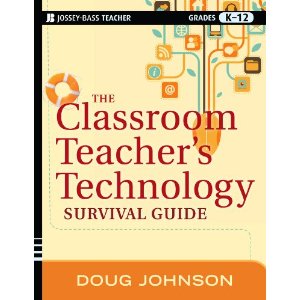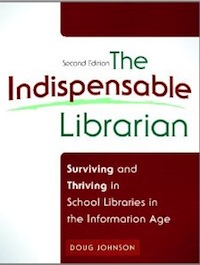School libraries as a "third place"
Head for the Edge, Library Media Connection, Aug/Sept 2010
Doug Johnson doug0077@gmail.com
The third place is a term used in the concept of community building to refer to social surroundings separate from the two usual social environments of home and the workplace. - Wikipedia
Is your library threatened by the 3R’s? Robes, Recliners and Refreshments? When accessing information I am far more often wearing a bathrobe, sitting in my recliner and enjoying a beverage than I am sitting in a physical library. (Oh, that is at home, not at work.) Such access though my laptop and wireless Internet connection is really comfortable and really convenient.
A growing number of your students, I’m sure, have their own version of these 3R’s in their own homes reducing the need for them to travel physically to the library to get “stuff.” What, we need to continue to ask ourselves, do our physical libraries offer that online access to resources cannot? A “third place” might be part of the answer.
Coined by sociologist Ray Oldenburg in his book A Great Good Place, the term “third place” has come to describe an area for informal social gathering outside of home (the first place) and work (the second place). Oldenberg suggests such environments are necessary for a healthy society and healthy individuals.
University of Wisconsin professor Constance Steinkuehler introduced me to this term in a lecture several years ago. Steinkuehler’s assertion was that online game environments like those in World of Warcraft have become third places for the players1. Since I am not a gamer, I more or less forgot the term.
Until I started doing some reading and thinking about library design in the secondary schools. Might, just might, the school library serve as a “third place” for students and staff, especially in communities where other “third places” such as teen-oriented public libraries, coffee shops or YMCAs do not exist?
This idea has been explored by public and academic librarians2 and several of the criteria of a third place are evident in how Valerie Diggs transformed her high school library into a “learning commons3.”
What are some of the characteristics of the third place? Oldenburg writes:
The character of a third place is determined most of all by its regular clientele and is marked by a playful mood, which contrasts with people’s more serious involvement in other spheres. Though a radically different kind of setting for a home, the third place is remarkably similar to a good home in the psychological comfort and support that it extends…[Third places] are the heart of a community’s social vitality, the grassroots of democracy, but sadly, they constitute a diminishing aspect of the American social landscape.
And what might this look like in a school library? A third place library might contain:
· Social interaction spaces where small groups can work and play
· Gaming both physical and virtual
· Collections of popular books, manga/graphic novels, music, and high interest magazines
· Access to workstations for social networking sites
· Displays of information on high interest materials (teen drinking, job opportunities, eating disorders, popular culture, etc.)
· Computer workstations for the creation of personal communications and art.
· Comfortable chairs and tables
Perhaps the resources in such an area are less critical than what can be considered “appropriate use” of such a space. This needs to be an area where it is OK for kids just to “hang out.” Where personal interests can be explored and supported. Where talking and working together is the norm. Where students always feel welcome. Where, as they once sang on the old television show Cheers, “everybody knows your name.”
Yes, yes, I understand that school libraries have a serious academic mission. One might run the risk of trivializing the school library program if its social environment overshadows its educational function.
I would encourage establishing a happy medium. Might the school library be the third place outside of regular school hours? Might some sections of the library be third place “zones”? It certainly needs to be a concept that is understood and supported by the building’s staff and administration.
A comment by one of my students many years ago has always stuck with me - that the school library was his “home away from home.” Schools do have the societal charge of helping teach social skills to students. Might actively working to make school libraries the students’ third place help do this?
________________________________________
1. Steinkuehler, C. & Williams, D. (2006). Where everybody knows your (screen) name: Online games as “third places.” Journal of Computer-Mediated Communication, 11(4), article 1.2. “Libraries as a Third Place,” North Suburban Library System. <www.nsls.info/themes/detail.aspx?themeID=28>
3. Wheelan, Debra Lau. MA School Library Transforms into a New Learning Commons. School Library Journal, December 10, 2008. www.schoollibraryjournal.com/article/CA6621531.html





Reader Comments